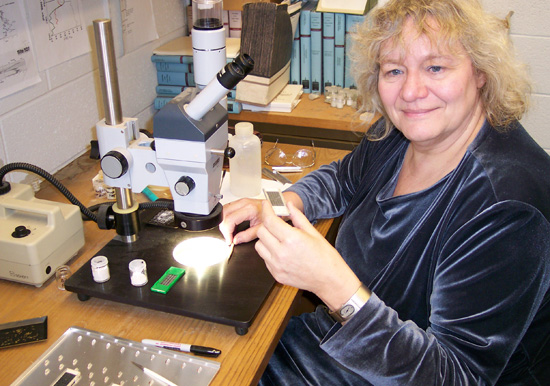Nitrogen Pollution May Be Affecting Long Island Sound’s Food Chain
 |
| Ellen Thomas, research professor in the Department of Earth and Environmental Sciences, gathered evidence that Long Island Sound has been impacted by human activities. |
| Posted 07/11/ 07 |
| A Wesleyan researcher has discovered that nitrogen pollution may have altered the food chain in Long Island Sound. This can threaten habitats that support large commercial and recreational fisheries.
Ellen Thomas, research professor in the Department of Earth and Environmental Sciences, has, together with Wesleyan undergraduate students, gathered evidence that Long Island Sound has been impacted by human activities, including effluents from wastewater treatment plants, waste disposal and urban and agricultural runoff. These effluents have given the Sound an overdose of nitrogen, causing a shift in the populations of microscopic algae which form the base of the food chain. This fundamental shift in the Sounds menu of who eats what is likely to cause many familiar species populations to decrease, she says. Some of the results of her research were described in the May 2007 edition of Soundkeeper, a newsletter published by local residents who advocate the patrolling, investigating, intervening and raising public awareness of Long Island Sound and its watershed. For 10,000 years, For 10,000 years, the single-celled organisms known as Elphidium excavatum fed off the Sound’s microscopic algae, or diatoms. Most crustaceans and fish, either directly or indirectly, thrived on diatoms, which are at the base of the Sound’s food chain. Many shellfish sieve diatoms from the waters, and the abundant small crustaceans called copepods thrive on diatoms. Without a large and healthy diatom population, the whole food chain suffers. In order for diatoms to thrive, they need an environment of nitrogen and silica, which they use to form their delicate skeletons. However, human-generated sources of nitrogen have thrown the nitrogen-silica ratio out of balance. “Humans add a lot of nitrogen to the Sound from polluted runoff and effluent from sewage treatment plants, but they do not add silica, so that ratio of nitrogen to silica becomes unfit for diatoms. As a result, other microscopic algae are out-competing diatoms for at least part of the growing season,” Thomas explains. The decrease in E. excavatum has also led to a rise in the species Ammonia beccarii , which is not a good food source for many organisms, including the copepods and most shellfish. It is a good food source for jellyfish, however, and Thomas fears these animals could begin to dominate the western Long Island Sound waterway, where the A. beccarii population is exploding. The decreasing population of E. excavatum signifies a fundamental shift in the Sounds food chain, Thomas says. Small diatom-feeding organisms form the base of a food chain that begins with diatoms and ends with animals we like to eat like lobster, scallops, and many fish. Thomas has researched foraminifera in Long Island Sound for more than 10 years, in cooperation with her husband Johan Varekamp, Harold T. Stearns Professor of Earth Science and chair of the Earth and Environmental Sciences. Many graduate and undergraduate Wesleyan students have participated in this research, some as Mellon and Hughes fellows. The research has been funded by Connecticut Sea Grant and the Long Island Sound Office of the Environmental Protection Agency. The Soundkeeper article is online at: More information on Long Island Sound studies by Ellen Thomas and Johan Varekamp is online at: http://ethomas.web.wesleyan.edu/lisweb |
| By Terry Backer and Julia Hyman, Soundkeeper contributors, and Olivia Drake, The Wesleyan Connection editor |

